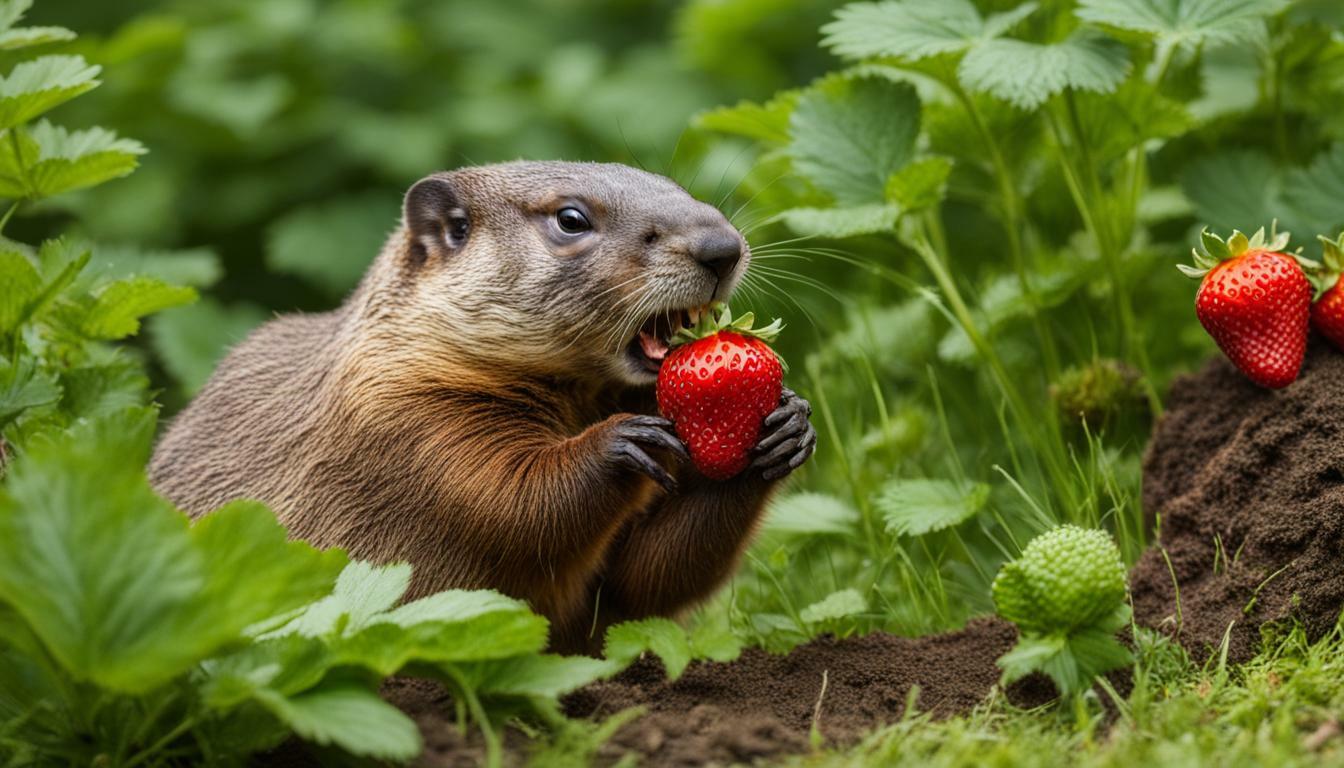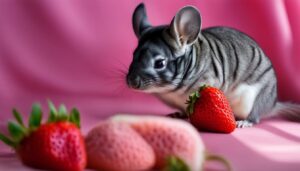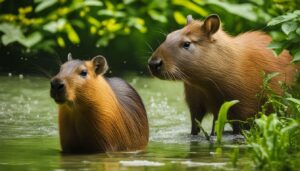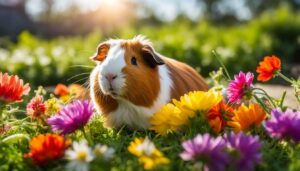Groundhogs are known for their varied diet, but do they have a particular liking for strawberries? In this article, we will explore the groundhog’s diet and food preferences, their behavior when it comes to consuming strawberries, and how to protect your strawberry plants from these curious creatures.
Key Takeaways:
- Groundhogs enjoy a variety of fruits and vegetables, including strawberries.
- Strawberries are not their primary food source, but groundhogs will eat them when other food is scarce.
- Groundhogs may leave unripe strawberries to ripen further before consuming them.
- Physical barriers, such as fencing or netting, can help protect strawberry plants from groundhog damage.
- Other animals, such as rabbits, squirrels, chipmunks, and birds, may also eat strawberries.
Groundhog Diet and Food Preferences
Groundhogs have a diverse diet that includes a wide range of fruits, vegetables, and other vegetation.
While they primarily feed on grasses, clover, and dandelions, they also enjoy indulging in fruits and vegetables when available.
This omnivorous diet allows groundhogs to adapt to different food sources throughout the year.
In terms of fruits, groundhogs are known to consume apples, pears, melons, and berries, including strawberries.
However, it’s important to note that strawberries are not a staple in their diet. Groundhogs are more likely to eat strawberries when other food sources become scarce.
When groundhogs consume strawberries, they may leave a jagged end when biting the berries off the stem.
Additionally, they may leave unripe strawberries to ripen further before consuming them. This behavior indicates that groundhogs have preferences for ripe and fully developed berries, just like humans do!
To protect your strawberry plants from groundhogs, consider using physical barriers such as fencing or netting.
Another option is to plant strawberries in raised beds or containers, which can make it more difficult for groundhogs to reach the plants.
It’s also worth considering companion planting, where groundhog-repellent plants are intermingled with your strawberry plants.
| Groundhog Diet | Groundhog Food Preferences |
|---|---|
| Grasses | Apples |
| Clover | Pears |
| Dandelions | Melons |
| Fruits | Berries |
While groundhogs can pose a threat to your strawberry plants, it’s important to remember that other wildlife may also have a taste for these delicious berries.
Animals such as rabbits, squirrels, chipmunks, and birds have been known to enjoy strawberries, potentially leading to competition for your harvest.
Taking the necessary precautions to protect your strawberry plants can help ensure that you’ll be able to enjoy the fruits of your labor.
Strawberry Consumption by Groundhogs
Groundhogs are known to come across strawberries in their habitat, but do they actually eat them? While strawberries are not a staple part of their diet, groundhogs do indulge in these delicious fruits when other food sources are limited.
Their consumption of strawberries can vary depending on availability and preference.
When groundhogs do eat strawberries, they may leave behind a jagged end when they bite the berries off the stem.
This behavior indicates their enjoyment and readiness to consume the fruit. However, it’s worth noting that groundhogs might leave unripe berries to ripen further before consuming them.
To protect your strawberry plants from groundhog damage, there are several strategies you can employ.
One effective method is to use physical barriers such as fencing or netting around your plants. These barriers create a deterrent, preventing groundhogs from accessing the strawberries.
Alternatively, consider planting strawberries in raised beds or containers, making it more difficult for groundhogs to reach and consume the fruits.
It’s important to remember that groundhogs are not the only animals that may be attracted to strawberries.
Other wildlife, including rabbits, squirrels, chipmunks, and birds, might also feast on these sweet treats.
Therefore, if you want to protect your strawberries, you may need to employ additional measures to deter other animals as well.
| Groundhog Interaction with Strawberries | Protection Methods |
|---|---|
| Groundhogs enjoy strawberries when other food is scarce | Use physical barriers like fencing or netting |
| Groundhogs may leave unripe berries to ripen before consuming | Plant strawberries in raised beds or containers |
| Other wildlife such as rabbits, squirrels, chipmunks, and birds may also eat strawberries | Consider additional measures to deter other animals |
By taking these precautions, you can enjoy a bountiful harvest of strawberries while minimizing the risk of damage from groundhogs and other wildlife.
Remember to observe and adapt your protection methods as necessary, ensuring that your delicious strawberries remain safely within your reach.
Groundhog Feeding Habits
Understanding groundhog feeding habits can provide insights into their likelihood of consuming strawberries.
While strawberries are not their primary food source, groundhogs have a diverse diet that includes a variety of fruits and vegetables.
When other food is scarce, groundhogs will not hesitate to munch on delicious strawberries.
When groundhogs encounter unripe strawberries, they may leave them to ripen further before indulging.
You may notice a jagged end left when they bite off the berry from its stem. This behavior suggests that groundhogs have a preference for fully ripe strawberries, but they won’t pass up the opportunity to enjoy them when hungry.
To protect your strawberry plants from groundhogs, physical barriers are essential. Fencing or netting around the garden area can effectively keep these curious critters at bay.
Alternatively, you can consider planting strawberries in raised beds or containers, making it more difficult for groundhogs to access the plants.
| Protecting your strawberries from groundhogs: |
|---|
| Use physical barriers like fencing or netting |
| Plant strawberries in raised beds or containers |
| Consider companion planting with other crops groundhogs are less likely to eat |
It’s important to note that groundhogs are not the only animals that may have a taste for strawberries.
Other culprits include rabbits, squirrels, chipmunks, and birds. So, additional measures may be necessary to protect your prized strawberries from these hungry visitors.
By understanding the feeding habits of groundhogs and taking proactive steps to protect your strawberry plants, you can enjoy a bountiful harvest while keeping these curious critters at a safe distance.
Protection Methods for Strawberry Plants
If groundhogs have a liking for strawberries, it’s important to protect your plants from their munching tendencies.
These furry critters can quickly decimate your strawberry patch, leaving you with nothing to harvest. Luckily, there are several effective methods you can employ to keep your precious strawberries safe.
Physical Barriers:
One of the most reliable ways to deter groundhogs is by installing physical barriers around your strawberry plants.
Fencing or netting can create a barrier that groundhogs cannot penetrate. Make sure the fence is buried at least a foot deep to prevent the groundhogs from digging underneath.
Additionally, ensure that the netting has small enough holes to prevent the groundhogs from squeezing through.
Alternative Planting Methods:
Another strategy is to plant strawberries in raised beds or containers. This makes it more difficult for groundhogs to access the plants.
You can also try interplanting garlic, onions, or marigolds around the strawberries. Groundhogs tend to dislike the strong odor of these plants, which may help deter them from venturing near your strawberries.
Consider Other Crops:
While strawberries are a delicious treat for groundhogs, they have other food preferences as well. By planting crops that groundhogs are less likely to eat, you can divert their attention away from your strawberries.
Some examples of groundhog-resistant plants include tomatoes, peppers, and herbs like basil and rosemary. Mixing these crops with your strawberry plants can create a natural deterrent.
| Protection Methods: | Effectiveness |
|---|---|
| Physical barriers (fencing or netting) | Highly effective |
| Planting in raised beds or containers | Effective |
| Interplanting with garlic, onions, or marigolds | Moderately effective |
| Growing other groundhog-resistant crops | Moderately effective |
Other Groundhog Food Preferences
While strawberries may be a popular choice, groundhogs have other food preferences to consider. These furry critters have a diverse palate and enjoy indulging in various fruits and vegetables.
Here are some other food options that groundhogs find delectable:
- Apples: Groundhogs have a particular fondness for apples, especially the sweeter varieties like Gala or Honeycrisp.
- Carrots: Crunchy and nutritious, carrots make a perfect snack for groundhogs. They are known to nibble on both the orange roots and the leafy greens.
- Lettuce: Leafy greens are a favorite among groundhogs. They happily munch on lettuce leaves, providing a refreshing and hydrating treat.
- Cucumbers: Groundhogs enjoy the crisp texture and mild flavor of cucumbers. These refreshing vegetables make a great addition to their diet.
- Squash: From zucchini to butternut squash, groundhogs appreciate the various types of squash available. The fibrous flesh gives them a satisfying chew.
While groundhogs have a preference for these food items, it’s important to note that they are opportunistic feeders and will consume a wide range of plant material.
Their preferences may vary depending on the availability of resources in their environment.
Groundhog Diet
Groundhogs are herbivores, primarily feeding on plants and vegetation. Their diet consists mainly of grasses, clover, dandelion greens, and other leafy greens.
They also supplement their diet with the occasional insect or snail. Groundhogs have a unique digestive system that allows them to efficiently process the fibrous plant material they consume.
| Groundhog Food Preferences | Additional Notes |
|---|---|
| Fruits | Groundhogs show a preference for fruits with a sweet flavor, such as apples and berries. |
| Vegetables | Leafy greens, carrots, and cucumbers are some of the vegetables that groundhogs enjoy. |
| Grasses | Groundhogs consume various types of grasses as a staple part of their diet. |
| Clover | Clover is a common food source for groundhogs, providing them with essential nutrients. |
| Insects | While not a significant part of their diet, groundhogs may occasionally consume insects or snails. |
Understanding the food preferences and dietary habits of groundhogs can help gardeners make informed decisions when it comes to protecting their crops. By diversifying the garden with other plants that groundhogs are less likely to eat, it’s possible to create a more balanced ecosystem and reduce the risk of crop damage.
Wildlife Interactions with Strawberries
Groundhogs are not the only wildlife that have a taste for strawberries. These luscious berries are also a favorite among rabbits, squirrels, chipmunks, and birds.
With their vibrant color and sweet aroma, strawberries can be irresistible to many creatures that inhabit our gardens and natural surroundings.
It’s important to understand how these animals interact with strawberries to effectively protect your plants and ensure a bountiful harvest.
When it comes to groundhogs, strawberries are not their primary food source, but they won’t hesitate to indulge in these juicy delights when other food options are limited.
Groundhogs may leave unripe berries to ripen further, displaying a preference for fully ripe fruits. If you notice jagged ends on strawberries, it could be a sign that a groundhog has been biting them off the stems.
This behavior reflects their willingness to enjoy strawberries as part of their varied diet.
To safeguard your strawberry plants from groundhogs and other wildlife, physical barriers are often an effective method.
Fencing or netting can be used to create a protective enclosure around your plants, preventing animals from accessing the berries.
Another option is planting strawberries in raised beds or containers, which can make it more difficult for groundhogs to reach the plants.
Additionally, incorporating companion plants that groundhogs are less likely to eat can help deter them from targeting your strawberries.
| Wildlife | Interactions with Strawberries |
|---|---|
| Rabbits | Rabbits are known to nibble on strawberry plants and pluck the ripe berries. |
| Squirrels | Squirrels are agile climbers and may scale strawberry plants to feast on the fruits. |
| Chipmunks | Chipmunks are notorious for snacking on strawberries, often leaving behind nibbled fruits. |
| Birds | Birds, such as robins and finches, may peck at strawberries, especially when other food sources are scarce. |
By understanding the interactions between wildlife and strawberries, you can take proactive measures to protect your crops.
Groundhogs and Unripe Strawberries
Do groundhogs have a preference for ripe strawberries or do they have the patience to wait for unripe ones to fully ripen? Let’s take a closer look at groundhog behavior when it comes to strawberries.
While groundhogs do enjoy strawberries, their preference tends to lean towards ripe ones. However, this doesn’t mean they won’t indulge in unripe berries.
In fact, groundhogs have been known to leave unripe strawberries on the plant, allowing them to ripen further before taking a bite.
When groundhogs do consume unripe berries, they often leave a jagged end where they bite them off the stem.
To protect your strawberry plants from groundhogs, it’s important to take preventative measures.
Consider using physical barriers such as fencing or netting to create a barrier between the groundhogs and your strawberries.
Another option is to plant your strawberries in raised beds or containers, making it more difficult for the groundhogs to access them.
Additionally, you may want to consider planting other crops that groundhogs are less likely to eat as a distraction.
| Groundhog and Strawberry Interaction | Groundhog Behavior |
|---|---|
| Eating ripe strawberries | Enjoyed as part of their diet |
| Eating unripe strawberries | May leave on plant to ripen further, leaving a jagged end when bitten off |
| Protecting strawberries | Use physical barriers like fencing or netting, plant in raised beds or containers, consider planting other crops as a distraction |
Remember, while groundhogs do eat strawberries, they also have preferences for other fruits and vegetables. By diversifying your garden and including crops that groundhogs are less likely to eat, you can reduce the risk of losing your entire strawberry harvest.
| Groundhog Food Preferences | Strawberry Consumption by Wildlife |
|---|---|
| – Fruits: apples, cherries, melons | – Rabbits |
| – Vegetables: lettuce, beans, peas | – Squirrels |
| – Grasses, clover, dandelions | – Chipmunks |
| – Bark, twigs, leaves | – Birds |
By understanding the food preferences of groundhogs and other wildlife, you can develop a planting strategy that minimizes the risk of strawberry consumption while still providing a habitat for these animals. Keep in mind that no method is foolproof, and regular monitoring of your garden is essential to address any potential issues.
Conclusion
Groundhogs do have a liking for strawberries, but with proper protection and consideration, you can still enjoy a fruitful harvest.
While strawberries are not the primary food source for groundhogs, they do enjoy a variety of fruits and vegetables, including these juicy berries.
However, it’s important to take steps to protect your strawberry plants from these furry foragers.
When food is scarce, groundhogs may turn to strawberries as a tasty snack. They have been known to leave a jagged end when biting off the stem of an unripe berry, indicating that they may wait for them to ripen further.
To ensure a bountiful strawberry harvest, it’s crucial to implement deterrents and preventive measures to keep groundhogs at bay.
Physical barriers such as fencing or netting can be effective in keeping groundhogs away from your strawberry plants.
Raised beds or containers can also help protect your crops, as groundhogs are less likely to access them.
Additionally, considering other crops that groundhogs are less inclined to eat can help minimize their interest in your strawberries.
It’s worth noting that other wildlife, such as rabbits, squirrels, chipmunks, and birds, may also have a taste for strawberries.
Therefore, it’s important to be vigilant and take steps to protect your plants from a range of potential invaders.
By implementing these strategies and taking precautions, you can enjoy a thriving strawberry patch while keeping groundhogs and other wildlife at bay.
FAQ
Do groundhogs eat strawberries?
Yes, groundhogs do eat strawberries, although they are not their primary food source. Groundhogs enjoy a variety of fruits and vegetables, and strawberries are one of the options they might consume.
How do groundhogs eat strawberries?
When groundhogs eat strawberries, they may leave a jagged end when biting them off the stem. They might also choose to leave unripe berries to ripen further before consuming them.
How can I protect my strawberry plants from groundhogs?
To protect your strawberry plants from groundhogs, you can use physical barriers such as fencing or netting. Planting them in raised beds or containers can also help. Additionally, consider growing other crops that groundhogs are less likely to eat.
What other animals might eat strawberries?
Apart from groundhogs, other animals that might eat strawberries include rabbits, squirrels, chipmunks, and birds.




